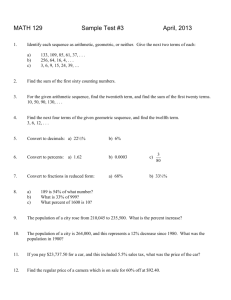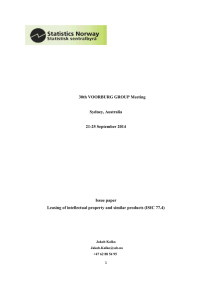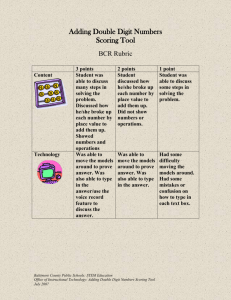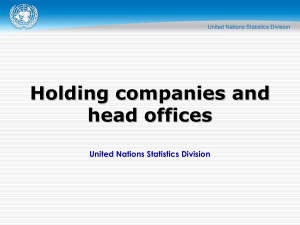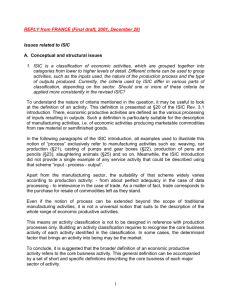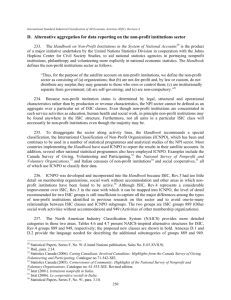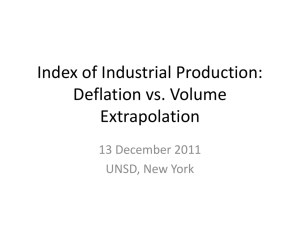spain - Concla
advertisement
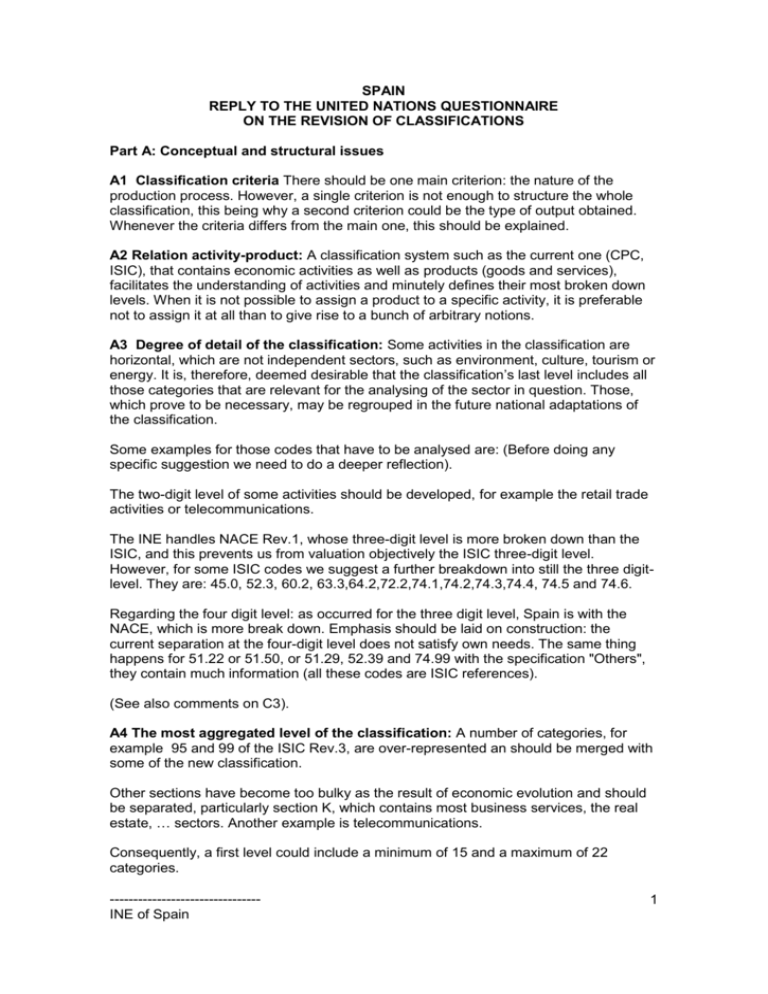
SPAIN REPLY TO THE UNITED NATIONS QUESTIONNAIRE ON THE REVISION OF CLASSIFICATIONS Part A: Conceptual and structural issues A1 Classification criteria There should be one main criterion: the nature of the production process. However, a single criterion is not enough to structure the whole classification, this being why a second criterion could be the type of output obtained. Whenever the criteria differs from the main one, this should be explained. A2 Relation activity-product: A classification system such as the current one (CPC, ISIC), that contains economic activities as well as products (goods and services), facilitates the understanding of activities and minutely defines their most broken down levels. When it is not possible to assign a product to a specific activity, it is preferable not to assign it at all than to give rise to a bunch of arbitrary notions. A3 Degree of detail of the classification: Some activities in the classification are horizontal, which are not independent sectors, such as environment, culture, tourism or energy. It is, therefore, deemed desirable that the classification’s last level includes all those categories that are relevant for the analysing of the sector in question. Those, which prove to be necessary, may be regrouped in the future national adaptations of the classification. Some examples for those codes that have to be analysed are: (Before doing any specific suggestion we need to do a deeper reflection). The two-digit level of some activities should be developed, for example the retail trade activities or telecommunications. The INE handles NACE Rev.1, whose three-digit level is more broken down than the ISIC, and this prevents us from valuation objectively the ISIC three-digit level. However, for some ISIC codes we suggest a further breakdown into still the three digitlevel. They are: 45.0, 52.3, 60.2, 63.3,64.2,72.2,74.1,74.2,74.3,74.4, 74.5 and 74.6. Regarding the four digit level: as occurred for the three digit level, Spain is with the NACE, which is more break down. Emphasis should be laid on construction: the current separation at the four-digit level does not satisfy own needs. The same thing happens for 51.22 or 51.50, or 51.29, 52.39 and 74.99 with the specification "Others", they contain much information (all these codes are ISIC references). (See also comments on C3). A4 The most aggregated level of the classification: A number of categories, for example 95 and 99 of the ISIC Rev.3, are over-represented an should be merged with some of the new classification. Other sections have become too bulky as the result of economic evolution and should be separated, particularly section K, which contains most business services, the real estate, … sectors. Another example is telecommunications. Consequently, a first level could include a minimum of 15 and a maximum of 22 categories. -------------------------------INE of Spain 1 A5 Methods for the election of codes: The most adequate method for the election of codes is the top-down, since the units codes are determined according to their importance from top to bottom. However, when a unit is a very big one and contains many secondary activities, its four digit level is arbitrary. Should a special regulation be created for statistical units where some secondary activities are significant? A6 Maintenance of time series : In statistics, the maintenance should be taken account of, this being why relevant structural changes in the new classification must be warranted by new economic facts. Summary of part A: A definition of the classification’s first level is essential and should be complied with in all national adaptations, while its last level must satisfy the analysis requirements as well as possible. It seems desirable that the first level, (and perhaps the second one) be the same for all countries; because a same classification is not possible for all of them, a compromise should be reached. The last level might contain between 400 and 500 categories, many more than the current one. If some countries consider this to big an amount, aggregation may be the solution. The three digit level, therefore, may be the best one for international comparability while the four digit level would include an interesting amount of items to describe what was called horizontal activities (tourism, environment, education, energy among others). In short, a solution should be found for those needing information on horizontal sectors. Part B: Cross-cutting issues B1 Information sector: The classification should show the new economy, provided that the definitions be agreed upon by the international forums, necessary condition for the sector’s incorporation. It is possible that not all users avail themselves of the same definition of this sector, this being why the second or third level headings should be fully consented to. Thus an improved international comparability is warranted. Furthermore, editing and printing are closely connected, the result often being that some enterprises will be classified in different sectors. B2 Repairs: The decision must be justified by the units’ analysis. There are two different types of repairs: those currently carried out in the industrial sector and the remaining ones. In the case of industrial machinery, the definition of repairs has to be very clear, since they may be small or big, the latter ones being able to prolong the life of the machine that may thus be considered as new. Also, repair shops usually are a section of the manufactory, even though for juridical, fiscal or accounting reasons, their firm name is different. We, therefore, suggest to include them in the industrial sector with a 4 digit level for the most significant items. -------------------------------INE of Spain 2 The repair of computers is obviously a computer service, often performed by enterprises engaged in other computer activities. These repairs should belong to a single category. Car repairs ought also be treated independently. B3 Installations: The issues considered for the above question also apply here. Moreover, some problems arise in the definition of the borderline between industry and construction as far as installations is concerning. B4 Supporting activities: Currently, these activities are a new production process, externalizing part of it. As this is essential in the future, it should be taken into consideration, although in some cases this approach is concerned with activities and in others with products. Three supporting activities/products are particularly important: Subcontracting part of the process. When this is a usual and clearly identified technique, the 4 digit level should be set apart and no empty classes should be created. In the classification of products, the subcontracted services should have a different code for each 4 digit class, independently from the solution given for this issue for the classification of activities . Enterprises engaged in assembling pieces, for toys, furniture, or other plastic or metallic product. The classification as an activity of the performances by the big enterprises’ head offices, which may have an influence on regional statistics. Part C: Content and boundary issues C1 Border lines between Industry and Agriculture and other sectors: The border line between industry and agriculture is very difficult to determine. For some agricultural units, like those producing wine, part of the activity is industrial. Should there be categories defined as agricultural holdings that transform their own produce ? Should the general norm be followed to classify them in the activity with the highest gross value added ? In the specific case of fish preserve ships that transform their catch on the high seas, they should be classified as industry, whereas they are included in fishery (Section B). According to the ISIC regulations for the classification of activities bordering commerce and industry, most of them should be considered industrial. A typical example is the retail trade of bread and bread products, at the establishments where they are produced, which is classified under 1541 (manufacture). This means in the first place, that most traditional small baker’s or pastry shops, clearly structured as commercial establishments (sales premises, counters, shop assistants), are shown as industrial activities. On the other hand, as they are small and their structure fluctuates between commerce and industry, it is doubtful whether they have been sufficiently investigated outside the commercial sector. Other examples, referred to canning and packing, may also illustrate the vacillation between industry and services and should be analyzed. -------------------------------INE of Spain 3 C2 Distribution and electronic commerce: The boundary between commerce and transport of products should be clearly defined. Although we are interested in the measurement of the electronic commerce, nothing has been suggested so far. Some traditional economic sectors, such as energy, currently contain enterprises devoted to commercialization, which are not included in the current classification for trade. C.3 Horizontal activities: The issues treated in question A3, regarding a classification’s level of detail. In our opinion it should be created several annexes will contain the most appropriate categories for horizontal industries, for example environment, tourism, education, energy, public health and environmental health. C4 Areas with economic changes: Obviously, all the considered activities that questionnaire point should be analyzed. We would also include in this list services to enterprises and professionals, as well as big enterprises’ headquarters, and subcontracting and assembling activities. There is an ever growing number of enterprises that set up businesses and correspondingly seek partners, but as soon as they are operative they are looking for a new business: where should these fresh activities be classified? C5 Globalization and deregulation : No comments C6 Division 50 (of the ?) ISIC – Commerce of AutomobileThis group should not be a single and independent one, even though activities such as repairs or the sale of fuel should be sufficiently represented, for which the maintenance of series is recommended. C7 Recycling: The ISIC Rev.3 division 37, recycling, is confusing, since its definition differs from the usual meaning of the word. It is, however, a very interesting activity in a society that is increasingly concerned with environment. But as recycling activities are usually vertically integrated into the productive processes, differentiating them is rather tricky. On the other hand, the boundary should be fixed between the wholesale scrap trade and the recycling item. Final Part: CPC: Comments on economic activities unavoidably lead to change products classifications, it therefore being desirable to launch a CPC revision process. Final considerations The classification revision is very important for our country and international proposals should be made available sufficiently in advance to allow their analysis and pertinent comments. It would therefore desirable to establish an international schedule for the tasks to be carried out. Besides the general suggestions in this document, there are more specific ones that will be put forward with the classification revision. -------------------------------INE of Spain 4 Finally, considering the purpose of this questionnaire, we would like to know the comments of other countries, even in case they are not taken into account for the new international classification. Madrid, 22nd November 2001 -------------------------------INE of Spain 5

